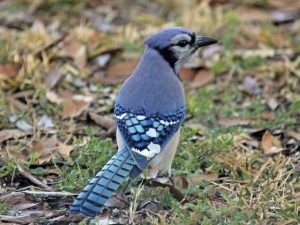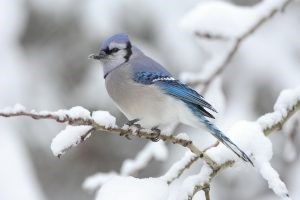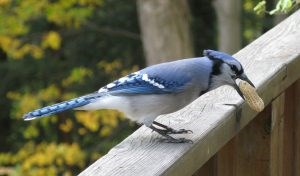This content was originally published by the Longmont Observer and is licensed under a Creative Commons license.
Purportedly revered by the Chinook people as a trickster god, the blue jay is a colorful and noisy inhabitant in many urban settings. I have several in my neighborhood that nest and they can be quite raucous at times! Whether they get your attention with their loud calls or their beautiful blue plumage, it is hard to miss when a blue jay is present. Blue jays are known to be very intelligent birds and they have a complex social system with tight family bonds.
Blue jays are smaller than crows, but larger than robins. They are 10-12 inches long and weigh 2.5-3.5 ounces. Their wingspan varies from 13-17 inches. Blue jays are white or gray in color on their bellies and undersides and have various shades of blue, black, and white above. They have a prominent crest on their head and a black stripe around their neck that could be described as a “necklace.” The wings and tail have black bars on them and each wing has a bold, white bar. Seen from below, the corners of the tail are white and the black “necklace” is visible. The pigment in blue jays’ feathers is actually brown, but blue jays have special cells on the barbs of their feathers that cause light to scatter in such a way that their feathers appear blue. The black pattern on the face, neck, and throat varies widely between individuals and may be used to help birds recognize each other.

Blue jays are typically found around the edge of forests, particularly where their favorite food, the acorn, is growing. They are credited with helping to spread acorn trees after the last glacial period. Blue jays tend to avoid pine forests. However, blue jays are also common in urban areas and will frequent bird feeders.
Blue jays are omnivorous, meaning they eat plant and animal matter. They eat insects, nuts, seeds, grains, berries, fruit, and dead or injured small vertebrates. They are also known to raid the nests of other birds for eggs and nestlings. Blue jays, as mentioned, are quick to take advantage of backyard bird feeders as well. They will hold the seeds between their feet and peck at them to open them. Blue jays prefer tray or hopper feeders on a post rather than hanging feeders. Their favorite foods at a bird feeder are peanuts, sunflower seeds, and suet. When they are feeding peacefully with their flock mates at a feeder, their crests are lowered.
Blue jays are also known to cache their food for later use. Acorns may be stored in holes in the ground. Studies show that blue jays are able to find their caches at a greater rate than would be expected by chance alone, indicating that they actually have some spatial memory of where they store food. Blue jays are able to carry food in their throat and upper esophagus, an area known as a gular pouch. This allows them to carry up to five acorns at a time, with two to three in the pouch, one in the mouth, and one in the tip of the bill!

During courtship, several males may chase a female, although it is not known for sure whether this is a territorial display rather than a courtship display. The male may feed the female during courtship. Blue jays mate for life and pairs stay together during the year. Nest building usually begins in mid-March. Nests are placed in the crotch of a tree or in thick branches 10-25 feet above the ground. Both members of the pair participate in nest building, with the male gathering more material than the female, and the female doing more of the building. The nest is built as a cup using live twigs, grass, and sometimes mud. The inner cup is lined with rootlets. If a predator is detected nearby, blue jays may abandon their nest.
The female lays between two and seven eggs, with the average being four or five. Incubation lasts for 17-18 days and the female does all the incubating. During incubation, the male provides the female with food.
The young are born helpless and naked (altricial). For the first 8-12 days, the female broods the young and the male brings food to the nest. Both parents will bring food for the nestlings after this time period. Nestlings can beg very loudly, but the parents may not feed them until they return to the nest. It is during this stage that many people think they have found an “abandoned” blue jay nest. If the nestling is out of the nest, you can place it in or near the nest and the parents will continue to feed it. The young are ready to leave the nest 17-21 days after hatching. Fledglings will remain with their parents for one to two months after leaving the nest.

Blue jays have an amazing range of vocalizations. There is the familiar jeer jeer call, but they are also excellent mimics. In captivity, blue jays have been known to imitate humans and the “meow” of cats. In the wild, blue jays often mimic the calls of red-shouldered and red-tailed hawks. Sometimes blue jays will mimic hawk calls as they approach a feeder, presumably to scare off the other birds.
Consider putting up a platform feeder or some suet for the blue jays in your neighborhood. I remember feeding the blue jays in my backyard one year with peanuts. Somehow, one of my dogs got it in his head that he wanted the peanuts and wanted them all to himself. It was funny to watch him trying to eat peanuts in the shell, which he obviously wasn’t enjoying, while the blue jay tried to carry off as many as it could. If you decide you don’t want blue jays at your feeder, you will need to only feed foods blue jays don’t like as much such as thistle and safflower seeds. When you hear their distinctive call, look around for the bird. You may just spot a trickster god!


